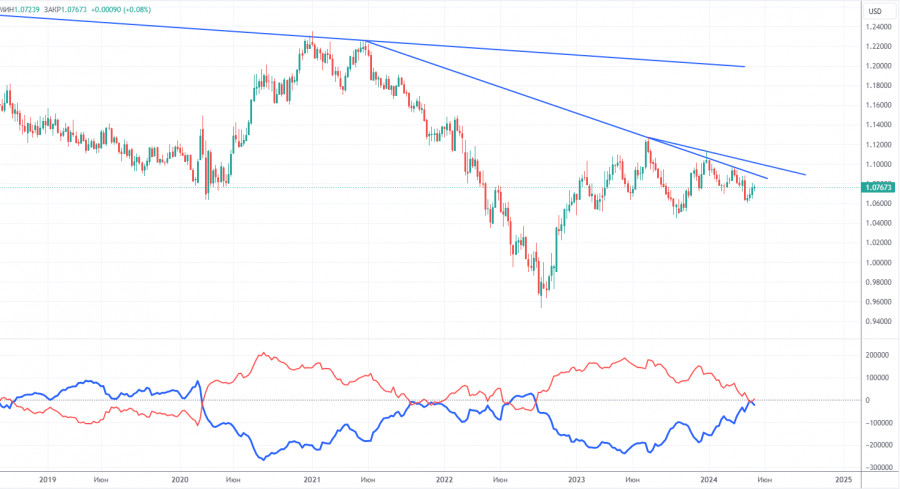Analysis of EUR/USD 5M

The EUR/USD pair went through a minor bearish correction on Thursday. It was so weak that it's unclear whether the pair will even drop to the Senkou Span B line. As mentioned before, the market has returned to its favorite routine of the past six months. This involves buying the euro on any pretext while buying the US dollar only on significant occasions. Much of the fundamental and macroeconomic background that is in favor of the dollar is either ignored or interpreted against it, which amounts to the same thing. To be fair, the last month has seen a lot of negative data from the US, which could and should have triggered the dollar's decline. However, the dollar has been falling much more frequently than the data would suggest. Moreover, the market ignores the fact that the Federal Reserve does not intend to lower the rate anytime soon.
Therefore, we do not see any reason for the euro to continue its upward movement and expect the downward trend to resume in the medium-term. However, we should also consider the possibility that if the market continues to maintain a bullish bias for no reason, the pair will not fall. Let's remember that the market is dominated by large players who can make trades independently of fundamental events and macroeconomic reports.
Only one trading signal was formed on Thursday – a sell signal. At the very beginning of the European trading session, the pair rebounded from the 1.0889 level, and by the evening, it had moved down by about 5-10 pips. Volatility was quite low, which naturally affected the number of signals and the size of the profit.
COT report:

The latest COT report is dated May 7. The net position of non-commercial traders has been bullish for quite some time, but now the situation has finally changed. The net position of non-commercial traders (red line) has been decreasing in recent months, while that of commercial traders (blue line) has been increasing. This shows that market sentiment is turning bearish, as speculators increasingly sell the euro. Currently, their positions coincide in terms of volume. We don't see any fundamental factors that can support the euro's strength, while technical analysis also suggests a downtrend. Three descending trend lines on the weekly chart indicate that there's a good chance of continuing the decline.
The red and blue lines have crossed, and now bears may have a significant advantage. So we strongly believe that the euro will fall further. During the last reporting week, the number of long positions for the non-commercial group increased by 3,400, while the number of short positions decreased by 7,900. Accordingly, the net position increased by 12,300. Overall, both the euro and the net position continue to decline. The number of buy contracts is only higher than the number of sell contracts among non-commercial traders by 4,000.
Analysis of EUR/USD 1H

On the 1-hour chart, the EUR/USD pair has been going through a steady bullish correction against the broader downward trend for a month. Since expectations for a Federal Reserve rate cut in 2024 have significantly decreased, we believe that the US currency should rise in the medium term. We still expect the price to consolidate below the ascending channel so the downtrend can resume. However, it seems that the market is not ready to buy the dollar under any circumstances.
On May 17, we highlight the following levels for trading: 1.0530, 1.0581, 1.0658-1.0669, 1.0757, 1.0797, 1.0836, 1.0886, 1.0935, 1.1006, 1.1092, as well as the Senkou Span B line (1.0734) and the Kijun-sen line (1.0830). The Ichimoku indicator lines can move during the day, so this should be taken into account when identifying trading signals. Don't forget to set a Stop Loss to breakeven if the price has moved in the intended direction by 15 pips. This will protect you against potential losses if the signal turns out to be false.
On Friday, the final estimate of the Eurozone inflation report will be published. Apart from this event, there will be nothing else of interest in either the US or the EU. Volatility will probably be low.
Description of the chart:
Support and resistance levels are thick red lines near which the trend may end. They do not provide trading signals;
The Kijun-sen and Senkou Span B lines are the lines of the Ichimoku indicator, plotted to the 1H timeframe from the 4H one. They provide trading signals;
Extreme levels are thin red lines from which the price bounced earlier. They provide trading signals;
Yellow lines are trend lines, trend channels, and any other technical patterns;
Indicator 1 on the COT charts is the net position size for each category of traders;
The material has been provided by InstaForex Company - www.instaforex.com #














 Download NOW!
Download NOW!
No comments:
Post a Comment